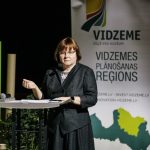What is the role of design in achieving the goals of the circular economy? How does design thinking contribute to the efficient use of resources? We propose to watch an inspiring video first time presented during the annual Vidzeme Innovation week in Latvia organized by Vidzeme Planning Region. Aija Freimane, an associate professor of the Latvian Academy of Arts and a leading postdoctoral researcher in design, shares her knowledge about the role of design in creating innovation and circular economy.
By presenting examples of the doctoral dissertation, Freimane outlines her vision of responsibility and the opportunities offered by the design approach on a regional and global scale. For example, how locally available resources can be used in the design to add value to the world both socially and economically. However, to define where we are and which path to take, we must look in the past. Freimane emphasizes the impact of human activities on climate change, geographical, technological, demographical, geological processes, and the economy. Human behaviour and actions have created the need to think about responsibility towards the environment and resource-saving.
Historically, society has experienced the conspicuous consumption, when people buy goods to show their status, and the opposite – anti-consumption when part of the public actively argue to consume less. The electricity consumption lobby has been experienced to stimulate the use of electrical appliances daily as well as the period when an artificially reduced product life cycle is constructed.
“Today, 80% of things are used only once and then end up in the big mountains of garbage. […] fashion, marketing, and fast-changing products mean that we have to consume something new every season,” explains Freimane.
Design is a method that defines the real need and creates a solution – better things, services and systems create satisfaction and happiness for a person. If things work for a long time, if we get good service, we feel happy. The primary task of design is to do it in the long run and anticipate the emotional feeling that arises after using things.
Based on the results of a study developed by Freimane, such characteristics as convenience, usefulness, aesthetics, durability, and personality are the five values of the product that users value the most.
In her lecture based on practical examples, Freimane emphasizes that anything we know we can do with new techniques, working together with professionals from different fields. Some of the inspiring circular economy innovations mentioned in the video are from students’ academic work:
– how to create products that even have export potential using the biggest food waste – coffee grounds?
– the creation of tactile and fragrant packaging for usage in zero-waste stores using citrus peel.
– mechanically obtained birch beam as a material to use when manufacturing clothes and other accessories.
Find out these and other examples by watching the video (18 min):





